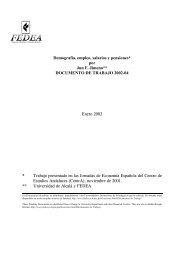The Evolution of Retirement by J. Ignacio Conde-Ruiz* Vincenzo ...
The Evolution of Retirement by J. Ignacio Conde-Ruiz* Vincenzo ...
The Evolution of Retirement by J. Ignacio Conde-Ruiz* Vincenzo ...
You also want an ePaper? Increase the reach of your titles
YUMPU automatically turns print PDFs into web optimized ePapers that Google loves.
supported <strong>by</strong> a Markovian politico-economic equilibrium satisfies:<br />
s<br />
τ t+1 = Q(Z(τ t )) = 1 2 − 1 1 − 2A − 2(1 + r)wa t Z(τ t ) 2<br />
2<br />
(1 + n t )w t+1<br />
where A, the free parameter pinned down <strong>by</strong> the first median voter’s expectation<br />
<strong>of</strong> future policies, is restricted to the support A ∈ [(1 + r)w a t , (1 + n t )w t+1 /2].<br />
Pro<strong>of</strong>. See Appendix.<br />
<strong>The</strong> result in proposition 2 points to the existence <strong>of</strong> a positive link between<br />
thecurrentuse<strong>of</strong>earlyretirementprovisions and the future social security<br />
contribution rate. This link completes the economic chanel running from the<br />
social security contribution rate to the current labor supply decision <strong>of</strong> the<br />
adults, as described at eq. 4. In particular, a current increase in the social<br />
security contribution rate leads to more current early retirement — <strong>by</strong> reducing<br />
the opportunity cost <strong>of</strong> retirement — which in turn creates expectations for more<br />
social security contributions — and hence more early retirement — in the future.<br />
In fact, since z t =1− τ t , the dynamics for the equilibrium policy function<br />
can be described as follows:<br />
τ t+1 = 1 2 − 1 2<br />
s<br />
1 − 2A − 2(1 + r)wa t (1 − τ t ) 2<br />
(1 + n t )w t+1<br />
(10)<br />
Furthermore, it is easy to show that dτ t+1 /dτ t<br />
∈ (0, 1), and thus the equilibrium<br />
path converges to a stable steady state with a positive social security<br />
contribution rate — and early retirement. As shown in figure 1, if the initial<br />
social security contribution is below the steady state level, the dynamics feature<br />
an increasing sequence <strong>of</strong> tax rate (and an increasing use <strong>of</strong> early retirement),<br />
which converges to the steady state.<br />
3.3 Aging, Social Security and Early <strong>Retirement</strong><br />
<strong>The</strong> equilibrium policy function obtained in the previous section allows us to<br />
analyze the effects <strong>of</strong> aging on the dynamics <strong>of</strong> the social security tax rate and<br />
13






